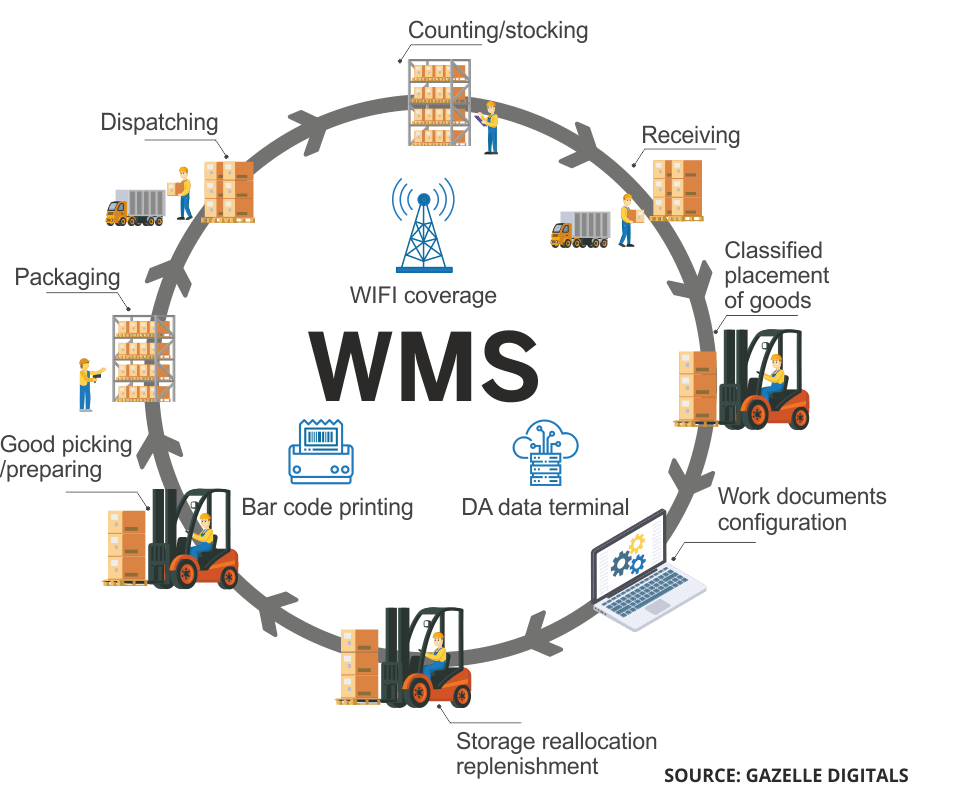In today’s competitive and fast-paced business environment, companies across industries face increasing pressure to streamline operations, cut costs, and meet growing customer expectations for speed and accuracy. Efficient management of warehouse operations is central to achieving these goals. Enter the Warehouse Management System (WMS)—a powerful tool designed to help businesses optimize and control their warehousing, inventory, and even sales operations.
Whether you’re a small business handling a few products or a large enterprise dealing with thousands of SKUs (stock-keeping units), a WMS plays a pivotal role in keeping operations running smoothly, ensuring orders are fulfilled correctly and efficiently. This, in turn, boosts sales by enhancing customer satisfaction and loyalty. But what exactly is a WMS, how does it work, and why is it such a vital tool for businesses today? Let’s dive in.
What is a Warehouse Management System (WMS)?
A Warehouse Management System (WMS) is a type of software that provides businesses with the tools to efficiently manage warehouse operations, including inventory tracking, order fulfillment, and logistics. It offers end-to-end inventory visibility, automates key processes like receiving, picking, packing, and shipping, and helps warehouse staff perform their tasks more efficiently. When handled efficiently, these processes directly contribute to more accurate and faster sales processes.
WMS can be integrated with other business systems such as Enterprise Resource Planning (ERP) software, Customer Relationship Management (CRM) systems, and Transportation Management Systems (TMS) to ensure seamless communication across all aspects of the supply chain and sales cycle.
Core Functions of a WMS
At its heart, a WMS offers several core functions to improve warehouse efficiency and indirectly boost sales. These include:
1. Inventory Management
WMS allows businesses to track their inventory in real time, providing a clear view of what stock is available, where it is stored, and what needs replenishing. Optimizing inventory levels ensures businesses are always ready to meet customer demand, which supports sales growth by avoiding stockouts or overstocking.
2. Order Fulfillment
One of the primary goals of a WMS is to ensure that customer orders are picked, packed, and shipped accurately and efficiently. By automating these processes, WMS helps to minimize errors, improve order accuracy, and shorten the time it takes to get products to customers—all of which lead to increased sales and customer satisfaction.
3. Warehouse Layout Optimization
The system assists in optimizing the warehouse layout by organizing products based on demand, size, or handling requirements. This makes it easier for employees to quickly access high-demand items, thereby speeding up the picking process and increasing overall efficiency, which can lead to quicker sales turnover.
4. Task Management and Labor Efficiency
WMS assigns tasks to warehouse employees based on their roles and the current workload. By improving labor efficiency, companies can process more orders faster, improving sales throughput.
5. Shipping and Receiving
The WMS automates the receiving process, ensuring that incoming goods are accurately checked, recorded, and stored. It also ensures that outgoing shipments are prepared and dispatched on time. A smoother, faster shipping process increases customer satisfaction, leading to repeat sales.
6. Reporting and Analytics
WMS provides detailed reports and analytics on warehouse operations. Managers can use this data to track key performance indicators (KPIs), identify bottlenecks, and make informed decisions to improve efficiency and support sales growth.
How Does a WMS Work?
A WMS works by streamlining various warehouse processes through a combination of automation and real-time data. Here’s a basic overview of how it functions:
1. Receiving Goods
When products arrive at the warehouse, the WMS tracks their receipt, verifies quantities, and records any discrepancies. It assigns storage locations based on the type of product and demand, ensuring stock is ready for quick turnover and supporting fast sales processing.
2. Inventory Management
The WMS continuously tracks inventory levels, updating the system in real time as products are moved, sold, or returned. This real-time data ensures that businesses always have an accurate picture of their stock levels and can plan for replenishment to meet future sales demand.
3. Order Picking
When an order is placed, the WMS generates a pick list that directs warehouse staff to the appropriate storage locations. Faster and more accurate picking ensures orders are completed promptly, positively impacting sales cycles by reducing delays.
4. Packing and Shipping
After picking, the WMS ensures that products are packed and labeled correctly. It also integrates with shipping carriers to streamline the shipping process and ensure that orders are dispatched efficiently. Timely deliveries enhance the overall customer experience, leading to future sales opportunities.
5. Returns Processing
The WMS also helps businesses handle returns efficiently by guiding warehouse staff through the process of receiving, inspecting, and restocking returned items. This reduces the likelihood of errors, maintains accurate inventory records, and helps retain customers who might otherwise look elsewhere for their next sales transaction.
Why is a WMS Essential for Modern Businesses?
In an increasingly competitive and customer-driven marketplace, the need for efficient warehouse operations has never been greater. Here are several reasons why a WMS is essential for modern businesses:
1. Improved Accuracy and Reduced Errors
By automating critical processes, a WMS helps reduce human error, particularly in order fulfillment, which is directly tied to customer satisfaction and ongoing sales. Fewer mistakes mean fewer returns and more happy customers.
2. Increased Efficiency
By automating manual tasks involved in warehousing, a WMS significantly increases efficiency. Faster processing times enable quicker order completion, directly supporting faster sales cycles and increased throughput.
3. Cost Savings
A WMS can help businesses save money by optimizing inventory levels, reducing errors, and improving labor efficiency. Lower operational costs can lead to more competitive pricing, which in turn may drive more sales.
4. Better Customer Service
Today’s customers expect fast, accurate service. A WMS ensures that orders are processed and shipped quickly and correctly, boosting customer satisfaction and paving the way for repeat sales.
5. Scalability
As businesses grow, managing warehouse operations manually becomes increasingly difficult. A WMS provides the scalability needed to manage larger volumes of inventory and orders, ensuring sales operations remain efficient and capable of handling increased demand.
6. Real-Time Visibility
One of the key benefits of a WMS is the real-time visibility it provides into warehouse operations. Businesses can track inventory levels, monitor order progress, and gain insights into performance, all of which help align supply chain activities with sales strategies.
Conclusion
A Warehouse Management System is an essential tool for businesses looking to improve efficiency, reduce costs, and enhance customer service. By automating key warehouse processes and providing real-time visibility into operations, a WMS helps businesses stay competitive in an increasingly fast-paced marketplace. From improving order accuracy to supporting seamless sales operations, the impact of a WMS is far-reaching, making it a must-have solution for any company looking to grow and succeed in the modern business world.



